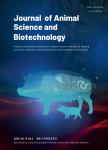Maternal supply of methionine during late-pregnancy enhances rate of Holstein calf development in utero and postnatal growth to a greater extent than colostrum source
Maternal supply of methionine during late-pregnancy enhances rate of Holstein calf development in utero and postnatal growth to a greater extent than colostrum source作者机构:Mammalian NutriPhysioGenomicsDepartment of Animal Sciences and Division of Nutritional SciencesUniversity of Illinois Department of AnimalDairy and Veterinary SciencesUtah State University Department of Animal MedicineFaculty of Veterinary MedicineKafrelsheikh University Department of Animal and Veterinary ScienceClemson University Evonik Nutrition & Care GmbH Department of Animal SciencesFood and Nutrition Faculty of AgricultureFood and Environmental ScienceUniversità Cattolica del Sacro Cuore
出 版 物:《Journal of Animal Science and Biotechnology》 (畜牧与生物技术杂志(英文版))
年 卷 期:2019年第10卷第1期
页 面:103-114页
核心收录:
基 金:supported by a postdoctoral fellowship from the government of the Arab Republic of Egypt
主 题:Epigenetics Metabolism Methyl donors Nutritional programming
摘 要:Background: Pregnancy and early life are critical periods of plasticity during which the fetus and neonate may be influenced by environmental factors such as *** methionine(Met) supply in non-ruminants during pregnancy can affect offspring development and ***,the objective of this study was to investigate if increasing Met supply during late-pregnancy affects developmental parameters of the calf at birth and if either maternal Met or colostrum from Met-fed cows alters calf *** born to Holstein cows individually-fed a basal control [CON; 1.47 Mcal/kg dry matter(DM) and 15.3% crude protein] diet with no added Met or CON plus ethylcellulose rumen-protected Met(MET; Mepron? at 0.09% of diet DM; Evonik Nutrition & Care GmbH,Germany)during the last 28 ± 2 d of pregnancy were used.A total of 39 calves were in CON(n = 22 bulls,17 heifers) and 42 in MET(n = 20 bulls,22 heifers).At birth,calves were randomly allocated considering dam treatment and colostrum as fol ows: 1) calves from CON cows and colostrum from CON cows(n = 21); 2) calves from CON cows and colostrum from MET cows(n = 18); 3) calves from MET cows and colostrum from MET cows(n = 22); and 4) calves from MET cows and colostrum from CON cows(n = 20).Al calves were housed,managed,and fed individual y during the first 9 wk of ***: Despite greater daily DM intake pre-partum in cows fed MET(15.7 vs.14.4 ± 0.12 kg/d,P 0.05),colostrum quality and quantity were not affected by maternal *** birth,MET calves had greater(P ≤ 0.05) body weight(BW,44.1 vs.42.1 ± 0.70 kg),hip height(HH,81.3 vs.79.6 ± 0.53 cm) and wither height(WH,77.8 vs.75.9 ± 0.47 cm).In contrast,concentrations of His,Lys,and Asn in plasma were lower(P ≤ 0.05) in MET *** of colostrum source,the greater BW,HH,and WH in MET calves at birth persisted through 9 wk of age resulting in average responses of + 3.1 kg BW,+ 1.9 cm HH,and + 1.8 cm WH compared with *** daily gain during the 9 wk was(P




